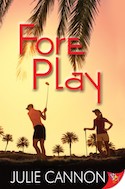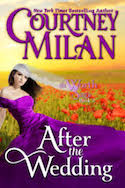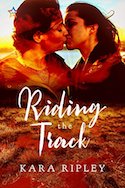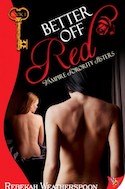Kissing Books: Ef-slash-ef = Pride
Every month, Olivia Waite pulls back the covers, revealing the very best in new, and classic, romance. We're extending a hand to you. Won't you take it? And if you're still not sated, there's always the archives.
It is embarrassingly easy to not realize you’re bisexual until age thirty-five.
You start by growing nervous as a tween because you haven’t had a crush on anyone, and all or most of your friends have. In my middle school Having A Crush was an accepted route to Being Interesting And Grown-Up, at least for the length of a slumber party, so it was stressful to be the only one not gushing over Tiger Beat heartthrobs with bowlcuts and multiple layers of shirt. Was there something wrong with me? Was I one of those lesbians people were just beginning to talk about where kids like me could hear? (This was a few years before Ellen.) How did I know who I was until I knew who I loved? When I finally did develop feelings for a boy — hyperbolic, helpless, dreamy feelings that were plenty easy to identify — I stamped the label straight on myself with some relief and considered the matter closed.
For twenty years. While I dated men and fell in love with men and married a man. That’s what you do when you’re a straight woman, right? Our wedding was on Pride Weekend, in the heart of Seattle’s queerest neighborhood, with six bridesmaids in different dresses wearing literally all the colors of the rainbow. Looking back, I’m a little embarrassed at how heavy-handed that foreshadowing turned out to be.
The insistence on being born this way or I always knew that inflects a lot of gay rights discourse has not been entirely helpful when it comes to the erasure of bisexuality. The questions whispered by that small voice in the back of my head could be so easily ignored. Sure, I tried to be an ally, and voted accordingly on every anti-discrimination and civil rights issue I could. Sure, I was occasionally poleaxed by how beautiful women could be. Sure, I’d occasionally think about kissing one — but that was just because our culture uses images of women when it wants to communicate about sex, right? So you learn to think of women as sexy because it’s a constant, neverending message, yeah? It’s not like it means anything. And I definitely liked men — some of them quite a lot! — so clearly I was really and truly straight. Or maybe I was doing it for the attention: secretly, silently swooning over the occasional woman without doing anything or telling anyone…for the attention. Sure, that makes sense.
And then, at age thirty-three, I decided it was time to diversify my reading and picked up my first f/f romance. Cathy Pegau’s Rulebreaker is a sci-fi heist story with a bisexual con artist heroine named Liv, who knows better than to fall in love with her mark, but does it anyway. I’m not at all surprised I loved it: it’s just my kind of catnip.
What did surprise me: it felt like coming home. Liv knows she’s bi but has never dated a woman, and her uncertainty about this new side of herself felt like a mirror I was looking into. The book is unusual in that it puts both m/f and f/f sex on the page — something a vocal subset of readers of queer romance object to, but which was helpful for me because it showed that Liv didn’t have to disavow her attraction to men to explore her attraction to women. It wasn’t that her history with men had been false, and this new side was The One Real Truth; it was about finding an additional piece of the puzzle. Gaining something, not losing something.
I’m not here to say that reading f/f romance made me queer — but it sure didn’t hurt.
I read every one I could find for the next three months. Sci-fi, fantasy, contemporary — good ones, really good ones, and ones that were only so-so. I started asking myself some rather pointed questions about tamped-down moments and experiences in my past. And then a couple years later Mr. Waite and I were watching Brooklyn 99 with gorgeous badass detective Rosa Diaz and the scales tipped. I recall being in the kitchen getting popcorn when Mr. Waite called out, “Hey Olivia, Rosa’s wearing a shoulder harness in this one.”
“Oh my gosh, really?” I sprinted in, trailing popcorn, the mini-dachshund bounding after to devour the fallen. And then I stopped, and turned to Mr. Waite with a furrowed brow. “These aren’t really platonic feelings to be having, are they?”
“No,” he said, laughing sweetly. “They’re not.”
Since then Stephanie Beatriz, the actress who plays Rosa Diaz, came out as bisexual. Then Rosa was revealed as bi in a milestone episode and got a girlfriend. This still feels eerie and magical, like when someone offers you a gift you may have wished for but never told anyone about. Several authors whose work I’d long loved came out as queer, as trans, as asexual. A lot of lighter TV shows practically exploded with bisexual characters. I learned I wasn’t the only one who took three or more decades to parse things out. It’s a dazzling feeling, after having been keeping a secret for so long, even from yourself, to be suddenly surrounded by mirrors.
It’s not all glitter and sparkles, of course — mirrors can have sharp edges, and spotlights aren’t always safe. We know who’s in the White House. I came out officially the day after the election because I wanted people to know where I stood, and with whom. It was an impulsive decision, but it was the right one, even though I’m still very much in processing mode. I may be for thirty more years, who knows? Every time I talk about it — even in passing, or in low-key pieces like this one — it feels like sliding one foot oh so carefully out past the edge of the cliff.
It may make me a bit breathless, but it’s a hell of a view.
Recent Romances:

Fore Play by Julie Cannon (Bold Strokes Books: contemporary f/f):
Romance author Gerri Russell once stated: “If your hero’s a firefighter, your heroine better be an arsonist.” (Any author with an arsonist heroine should pitch me immediately.) And it’s certainly one way to build a romance: one character’s wealthy and the other’s broke, one character’s grumpy and cynical and the other’s a sunny beacon of pure golden optimism. But simple difference is not the same thing as a meaningful contrast: there needs to be some connective material in the middle, or else it’s just a mismatch. You might as well try to drink whiskey from a pint glass (not recommended).
This book tried to do something really interesting: treat an ex-con heroine’s experience seriously without softening the facts of it even a little bit. Peyton’s part of this book is a gritty, blue-collar tale about people who’ve been hard done by and who have to make imperfect choices to protect the ones they care about. This could have made for a really unique, brave romance. She killed a man who needed killing, served hard time, and now works as a golf pro/caddy/beverage server at the club her brother runs. Unfortunately, she’s paired with a heroine who seems to have been pulled from another book entirely — Leigh is a female CEO right out of the escapist, glamorous realm of Harlequin Presents. She drives an imported car, wears designer clothing, and does adrenaline-fueled sports on the weekend (motorcross) to work off the stress of the corporate world. Leigh is determined to become a better golfer to impress her wealthy colleagues and boss. Peyton is DIY-installing secret video cameras in her apartment to film the abusive midnight visits of her parole officer, who likes to trash her apartment and cop a predatory feel.
These two have absolutely nothing in common except that they really want to fuck each other. And they don’t even do that until nearly seventy percent of the way through the book! And then it’s just sex — no bonding, no sharing, no establishing of any kind of partnership outside nudity and bedsheets. It feels like the author is trying to corral them into a relationship, and the characters are digging in their heels. The only reason I finished the book was to see how long our heroines could hold out against authorial pressure. Some romance novels, like some relationships, are just not meant to be.
Leigh’s heart was pounding, and surely Peyton could feel it. Peyton stiffened, then relaxed against her, then quickly stepped away.

The Princess Deception by Nell Stark (Bold Strokes Books: contemporary f/f):
Nell Stark’s Princess Affair series of lesbian royalty romances is pure luxury escapist pleasure reading, straight up, no chaser. This latest volume is a contemporary retelling of Twelfth Night that involves a World Cup bid, a pro soccer player-turned-journalist, and a Belgian princess impersonating her twin brother while he recovers from an overdose. It’s as high-concept as it comes, but grounded in some beautifully potent feelings. Duke’s loss of her professional soccer career due to an injury is still raw and poignant, and it puts her in the right place to appreciate Viola’s grief and anger about her brother’s newly revealed addiction. This is the kind of connective tissue that was missing from Fore Play — the sense of a shared struggle, or at least shared understanding of parallel struggles. Both heroines are reeling, in that dizzy headspace where bad ideas seem like great ideas. Impersonating your twin brother is the only way to win the World Cup bid! Flirting with that princess you’ve discovered in disguise is a great way to boost your journalism career! Things go predictably to hell in all the best ways and it’s great, smart, angsty fun for the reader. Themes of exposure, revelation, coming out, and disguise intertwine to keep things feeling complex without overwhelming. The slender mystery subplot and beautifully rendered, rare locations (Amsterdam! Prague!) are the frosting on the cupcake. A+ travel reading to lose yourself in on a long flight or a lazy beach.
”Some memories have a shelf life,” she finally said. “An expiration date, beyond which they aren’t useful.”

After the Wedding by Courtney Milan (self-published: historical m/f):
Speaking of cross-class romance and characters in disguise … Courtney Milan’s latest Worth Saga book is a glorious, achy, writhe-on-the-couch-making-wordless-squeaks-of-mingled-agony-and-delight heartbreaker of a romance between an earl’s daughter-turned-serving maid and a half-black porcelainware designer whose uncle is a politically ambitious bishop. We start on page one with a shotgun wedding and things get increasingly fraught from there — it has all the intrigue you miss from the old crazysauce days of greats like Bertrice Small and Laura Kinsale, plus a pragmatic view toward queer lives in the 19th century (Camilla is bisexual, and one particularly memorable secondary character is delightfully frank about her lesbianism). The series’ first book Once Upon a Marquess had a heroine with an atrocious temper, and this one has Camilla, the loneliest, thirstiest, most love-starved heroine since possibly Jane Eyre herownself. But where Jane is cautious and stoic and principled, Camilla is flirtatious, impulsive, and embarrassingly hopeful in spite of everything the world has done to break her down. I loved her, and the on-page chemistry between her and Adrian — who is too open, too giving, and too painfully willing to offer kindness even to those who hurt him — is a deep well of conflict as well as comfort.
One early moment from our hero and heroine’s first meeting shows how complex romance can really be for longtime readers: “Funny, how much more striking that contrast of crisp linen was with his brown skin than it would have been on a white man. He made everybody else seem utterly pallid by comparison.” One of the most well-worn tropes in romance is describing the two skin tones of hero and heroine when they’re in bed together: gold against pearl, or olive against porcelain. I must have read some variation on this no fewer than five hundred times. The hero in these scenes is almost always white — it’s not about him actually being a character of color, but of him being temporarily racialized for a cheap erotic charge based on his difference from the heroine. Milan’s phrasing here preserves the charge — the appealing aesthetic shock of deep brown skin against bright white linen — but her phrasing connects the hero and heroine rather than differentiating them. “He made everybody else seem utterly pallid” shows that already Camilla is drawn to Adrian not because he is different from her, but because he is different from the duller, pettier, crueler people she’s known in her difficult life. It’s unobtrusive to new romance readers, but a gem for longtime genre lovers. As with the first book, this one ends with a bit of a twist to set up the next in the series — I can’t wait to see where we’re going.
What luck, that they had married at gunpoint, she had perhaps hoped he would say. God, it sounded stupid even admitting it in her head.

Riding the Track by Kara Ripley (NineStar Press: contemporary f/f):
I loved this book — until I loathed this book.
There are a few things you don’t do in romance. You do not kill the dog. You do not have one character cheat on the other (whether polyamory or scene play counts as cheating is a constant debate topic). And you do not, you absolutely do not have the story end with the characters not together. Whether they’re just trying it out (Happy For Now) or in it to win it (Happily Ever After), you have to end the book with your h/h (or h/h/h+, for you ménage readers) as a joined unit.
This book puts on riding boots and stomps that rule into the muck. I have rarely been so angry and disappointed to hit the end of a story. I read it three times to make sure, but it’s crystal clear: our narrator-heroine goes back to the States, and the hot Australian lesbian cowgirl stays in the Outback.
It didn’t have to be like this.
Reader, I did my due diligence: this is a book I found in the Romance category on NetGalley, from a familiar romance publisher. It has a clinch cover, for the love of Garwood. The writing is superb: snarky, informal, self-deprecating, and keenly observed. Took the author less than two pages to win me over completely. Even learning that the book was a short novella rather than a full-length novel didn’t bother me. Life moves pretty fast; novellas are a great way to get in a full story without a lot of time investment. No length complaints here, if the story feels fleshed-out.
This one did. Until the very last page. Our heroines — cynical heartbroken American Clara, and earnest Australian cowgirl Evie — are finally hooking up, after three days of riding and flirting along the Oodnadatta Track. The descriptions of the landscape, the sharp banter, our narrator’s internal self-scolding, the mischievous heifer she names Little Mo-Mo…it was all so good. I had a set of blissful notes all typed up ready for review. All I was waiting for was the hint of hope for the future, that little chime to let me know I could let go of all the tension I’d accumulated as a reader. The book wound me up, and wound me up, and wound me up — and then it split the heroines up because the vacation was over.
The most unsatisfying part of reading ebooks is not the fact that they don’t smell like paper and ink: it’s the fact that you can’t hurl them across the room when they’ve betrayed you.
This book is a bait-and-switch, plain and simple. The reason I’m putting this book in this column, even though it is clearly not a romance by the only definition that matters, is because I don’t want anyone else to get burned the way I have been.
Tell your friends. Spread the word. Save them from betrayal.
The land kept going, a great sleeping serpent of ochre rock, sand, and dust.
This Month’s Vampire Romance But Not Like That

Better off Red by Rebekah Weatherspoon (Bold Strokes Bookes: paranormal f/f):
Before there was Dracula, there was Carmilla, a lesbian vampire serial. Later lesbian vampires became a whole Thing in horror cinema and pulp fiction, where the sinful, evil temptations of queer sex and female power mingled to terrify and titillate audiences assumed to be universally straight and male. Weatherspoon’s Vampire Sorority Sisters series (does what it says on the tin!) is definitely having fun with this tradition: the vampire heroine is named Camila, there’s a lot of juicy group sex just for the lush, smutty fun of it, and the plot touches on themes of power, control, violence, and living a life in the shadows. But this series is definitely pitched at queer women, by a queer woman, and it shows; the conflict comes from strong personal relationships rather than predatory hunter-and-hunted patterns, consent is actively debated, and the third book in the series recently won the Lambda for LGBTQ Erotica. It’s more Gothic than gory, and if you’re looking for something that puts a modern twist on that classic governess-in-peril mood, this is a great place to start.
Were amazingly good looks reason enough to trust your blood lusting captor?